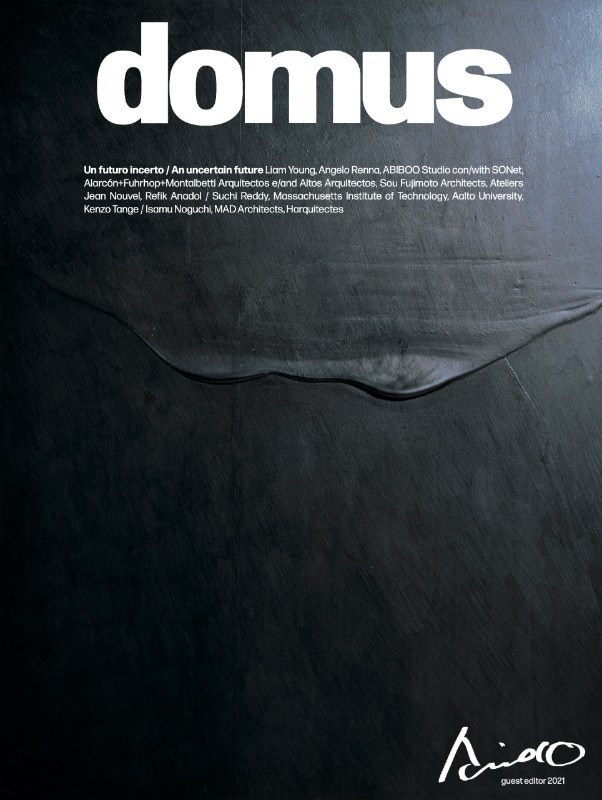The November issue of Domus 1062 outlines possible narratives for imagining a new future. In his editorial, Guest Editor Tadao Ando reflects on the visionary power of the “unbuilt” projects of yesterday and today. “The present is a challenging age where it is difficult to imagine utopian fantasies and robust proposals similar to the past. Still, creators continue the battle to grasp an uncertain future.”
Following in the Essays, Neyran Turan, co-founder of Nemestudio, attempts to re-examine the political mechanisms behind an architectural project in order to stimulate a new way of imagining the planet. Lebanese architect Zeina Koreitem, then, explains her proposal for a third way of computational representation compared to the two dominant ones, rendering and culture of fabrication. With her “proto-architectural” experiments, she reinforces the idea that color is numerical and that objects are data as well as material.
The Architecture section presents six projects not yet built, spatial visions that anticipate the future. Liam Young presents his animated short film, with which he explores an extreme possibility for the survival of mankind, where the entire population of the Earth retreats into one big city. Angelo Renna tells us about his vision for the historic San Siro stadium, a monument dedicated to the victims of Covid-19 transformed into an ecosystem of cypress trees; while ABIBOO Studio with SONet dream of a futuristic urban project on Mars. In Chile, Alarcón+Fuhrhop+Montalbetti Arquitectos and Altos Arquitectos present their proposal for the new Nuevo Museo de Arte Contemporáneo; Sou Fujimoto Architects explain two design proposals based on a strategy to mitigate the Middle Eastern climate. Finally, Jean Nouvel elaborates on his project for the Paleolithic wall art complex in Montignac, France.
In the pages dedicated to Art, Angela Maderna focuses on the work of artists Suchi Reddy and Refik Anadol, Could it in the future be created by Artificial Intelligence, independently of the will, guidance and supervision of the artist?
In the Design section we tell about four research projects, at Aalto University in Helsinki and MIT in Boston, testing new materials: augmented, thanks to technology, or biocompatible, starting from nature
The new Creators section was established to illustrate the variety of thought forms that can emerge around an idea. Each month we will offer a range of artists and designers who shape objects, spaces and buildings the chance to express themselves visually on the theme we investigate in the issue. For this issue, we’ve asked designers such as Steven Holl, Neri Oxman, Zhu Pei, Dominique Perrault and others to focus on the question "What future will we have?"
In the Design snippets column, Riichi Miyake recalls Kenzo Tange’s design of the Hiroshima Memorial owes much to Isamu Noguchi’s intervention-a collaboration nipped in the bud that deserves to be rediscovered. Mad Architects writes about the construction site of the Lucas Museum in Los Angeles, an organic structure, raised by arches to house a square at its center.

In this month’s Diary, pages dedicated to current events, a round table between Andrea Cassi, Georgina McDonald, James Taylor-Foster and Antonio Bosio discusses the new role of technology in the domestic environment. Carlos D’Ercole visits the house-studio of Luigi Serafini, an explosion of colors where red and white are the masters. Silvana Annicchiarico analyzes the design of the young Finnish designer Riku Taneli Toivonen, while Rita Capezzuto meets Hashim Sarkis, to take stock of his Biennale that has gathered the visions of 114 architects from all over the world. Editorial director Walter Mariotti concludes the section with a chat with Giorgio Rossi Cairo, one of the most eclectic figures in the Italian business community. He talks about his biodynamic vision and his experience at La Raia, where he promotes art and culture in the landscape.
Also this month in the attachment, the Contract special dedicated to the latest innovative proposals for offices and hotels. Cecilia Fabiani talks with the designers Elisa Ossini, Nani Marquina, Bernhard Osann and Philippe Starck, in search of new solutions for an evolving market. Valentina Croci investigates the office “that will be”: new flexible spaces marked by a renewed corporate culture, an important field of research after the pandemic has made traditional workplaces obsolete. Following, an investigation into the revolution that has involved hospitality spaces, changing form, and formula, to open up to the territory and take on a public role and contribute to urban renewal.

Technology and design for innovative washrooms
Fumagalli, a leader in the washroom industry, offers innovative and customizable solutions, combining design, efficiency and sustainability for contemporary and functional environments.

































